|

 Up
Up 
 Some
Some
Aeronutical Experiments

(You are here.)



  Need
to Need
to
find your
bearings?
Try
these
navigation aids:
If
this is your first
visit, please stop by:
Something
to share?
Please:



|
|
In
Their Own Words
 he
following speech was presented to the Western Society of Engineers in
Chicago, Illinois on September
18,1901 by Mr. Wilbur Wright of Dayton, Ohio. President
Octave Chanute introduced the speaker: he
following speech was presented to the Western Society of Engineers in
Chicago, Illinois on September
18,1901 by Mr. Wilbur Wright of Dayton, Ohio. President
Octave Chanute introduced the speaker:
"Engineers have,
until recent years, fought shy of anything relating to aerial
navigation. Those who ventured, in spite of the odium attached to that
study, to look into it at all became very soon satisfied that the great
obstacle in the way was the lack of a motor sufficiently light to
sustain its weight and that of an aeroplane upon the air. Fifteen years
ago the lightest steam motor was the marine engine, weighing 60 pounds
to the horsepower, while the gas engine weighed very much more; the
locomotive weighed 200 pounds per horsepower. During the past fifteen
years a great change has taken place. Steam motors have been produced
weighing only 10 pounds per horsepower, and gas engines have been
lightened down to 12 1/2 to 15 pounds per horsepower, so that the
status, so far as engineers are concerned, is very greatly changed, and
there is some hope that, for some limited purposes at least, man will
eventually be able to fly through the air. There is, however, before
that can be carried out – before a motor can be applied to a flying
machine – an important problem to solve – that of safety or that of
stability. “I had the honor of telling you, some four or five years ago,
something about the progress that had been made up to that time. Since
then further advances have been made by two gentlemen from Dayton, Ohio
– Mr. Wilbur Wright and Mr. Orville Wright – who tried some very
interesting experiments in October, 1900. These experiments were
conducted on the seashore of North Carolina, and were again resumed last
July. These gentlemen have been bold enough to attempt some things which
neither Lilienthal, nor Pilcher, nor myself dared to do. They have used
surfaces very much greater in extent than those which hitherto had been
deemed safe, and they have accomplished very remarkable results, part of
which it was my privilege to see on a visit, which I made to their camp
about a month ago. “I thought it would be interesting to the members of
this society to be the first to learn of the results accomplished, and
therefore I have the honor of presenting to you Mr. Wilbur Wright."
CoNtrol is Key
The difficulties
which obstruct the pathway to success in flying-machine construction are
of three general classes: (1) Those which relate to the construction of
the sustaining wings; (2) those which relate to the generation and
application of the power required to drive the machine through the air;
(3) those relating to the balancing and steering of the machine after it
is actually in flight. Of these difficulties two are already to a
certain extent solved. Men already know how to construct wings or
aeroplanes which, when driven through the air at sufficient speed, will
not only sustain the weight of the wings themselves, but also that of
the engine and of the engineer as well. Men also know how to build
engines and screws of sufficient lightness and power to drive these
planes at sustaining speed. As long ago as 1884 a machine weighing 8,000
pounds demonstrated its power both to lift itself from the ground and to
maintain a speed of from 30 to 40 miles per hour, but failed of success
owing to the inability to balance and steer it properly. This inability
to balance and steer still confronts students of the flying problem,
although nearly eight years have passed. When this one feature has been
worked out, the age of flying machines will have arrived, for all other
difficulties are of minor importance.
The person who
merely watches the flight of a bird gathers the impression that the bird
has nothing to think of but the flapping of its wings. As a matter of
fact this is a very small part of its mental labor. To even mention all
the things the bird must constantly keep in mind in order to fly
securely through the air would take a considerable part of the evening.If I take this piece of paper, and after placing it parallel with the
ground, quickly let it fall, it will not settle steadily down as a
staid, sensible piece of paper ought to do, but it insists on
contravening every recognized rule of decorum, turning over and darting
hither and thither in the most erratic manner, much after the style of
an untrained horse. Yet this is the style of steed that men must learn
to manage before flying can become an everyday sport. The bird has
learned this art of equilibrium, and learned it so thoroughly that its
skill is not apparent to our sight. We only learn to appreciate it when
we try to imitate it. Now, there are two ways of learning to ride a
fractious horse: One is to get on him and learn by actual practice how
each motion and trick may be best met; the other is to sit on a fence
and watch the beast a while, and then retire to the house and at leisure
figure out the best way of overcoming his jumps and kicks. The latter
system is the safest, but the former, on the whole, turns out the larger
proportion of good riders. It is very much the same in learning to ride
a flying machine; if you are looking for perfect safety, you will do
well to sit on a fence and watch the birds; but if you really wish to
learn, you must mount a machine and become acquainted with its tricks by
actual trial.
Gliding as a Way to Learn Control
Herr Otto
Lilienthal seems to have been the first man who really comprehended that
balancing was the first instead of the last of the great problems in
connection with human flight. He began where others left off, and thus
saved the many thousands of dollars that it had theretofore been
customary to spend in building and fitting expensive engines to machines
which were uncontrollable when tried. He built a pair of wings of a size
suitable to sustain his own weight, and made use of gravity as his
motor. This motor not only cost him nothing to begin with, but it
required no expensive fuel while in operation, and never had to be sent
to the shop for repairs. It had one serious drawback, however, in that
it always insisted on fixing the conditions under which it would work.
These were, that the man should first betake himself and machine to the
top of a hill and fly with a downward as well as a forward motion.
Unless these conditions were complied with, gravity served no better
than a balky horse – it would not work at all. Although Lilienthal must
have thought the conditions were rather hard, he nevertheless accepted
them till something better should turn up; and in this manner he made
some two thousand flights, in a few cases landing at a point more than
1,000 feet distant from his place of starting. Other men, no doubt, long
before had thought of trying such a plan. Lilienthal not only thought,
but acted; and in so doing probably made the greatest contribution to
the solution of the flying problem that has ever been made by any one
man. He demonstrated the feasibility of actual practice in the air,
without which success is impossible. Herr Lilienthal was followed by Mr.
Pilcher, a young English engineer, and by Mr. Chanute, a distinguished
member of the society I now address. A few others have built gliding
machines, but nearly all that is of real value is due to the experiments
conducted under the direction of the three men just mentioned.
Weight Shifting As a Means of Control
The balancing of a
gliding or flying machine is very simple in theory. It consists in
causing the center of gravity to coincide with the center of pressure.
But in actual practice there seems to be an almost boundless
incompatibility of temper which prevents their remaining peaceably
together for a single instant, so that the operator, who in this case
acts as a peacemaker, often suffers injury to himself while attempting
to bring them together. If a wind strikes a vertical plane, the pressure
on that part to one side of the center will exactly balance that on the
other side, and the part above the center will balance that below. But
if the plane be slightly inclined, the pressure on the part nearest the
wind is increased and the pressure on the other part decreased, so that
the center of pressure is now located, not in the center of the surface,
but a little toward the side which is in advance. If the plane be still
further inclined the center of pressure will move still farther forward.
and if the wind blow a little to one side it will also move over as if
to meet it. Now, since neither the wind nor the machine for even an
instant maintains exactly the same direction and velocity, it is evident
that the man who would trace the course of the center of pressure must
be very quick of mind; and he who would attempt to move his body to that
spot at every change must be very active indeed. Yet this is what Herr
Lilienthal attempted to do, and did do with most remarkable skill, as
his two thousand glides sufficiently attest. However, he did not escape
being overturned by wind gusts several times, and finally lost his life
as the result of an accidental fall.
The Pilcher machine was similar to
that of Lilienthal. On one occasion, while exhibiting the flight of his
machine to several members of the Aeronautical Society of Great Britain,
it suddenly collapsed and fell to the ground, causing injuries to the
operator which proved sadly fatal. The method of management of this
machine differed in no important respect from that of Lilienthal, the
operator shifting his body to make the centers of pressure and gravity
coincide. Although the fatalities which befell the designers of these
machines may have been due to the lack of structural strength rather
than to lack of control, nevertheless it had become clear to the
students of the problem that a more perfect method of control must be
evolved.
The Chanute machines marked a great advance in both respects.
In the multiple wing machine the tips folded slightly backward under the
pressure of the wind gusts, so that the travel of the center of pressure
was thus largely counterbalanced. The guiding of the machine was done by
a slight movement of the operator’s body toward the direction in which
it was desired that the machine should go. The double-deck machine,
built and tried at the same time, marked a very great structural
advance, as it was the first in which the principles of the modern truss
bridges were fully applied to flying-machine construction. This machine,
in addition to its greatly improved construction and general design of
parts, also differed from the machine of Lilienthal in the operation of
its tail. In the Lilienthal machine the tail, instead of being fixed in
one position, was prevented by a stop from folding downward beyond a
certain point, but was free to fold upward without any hindrance. In the
Chanute machine the tail was at first rigid, but afterwards, at the
suggestion of Mr. Herring, it was held in place by a spring that allowed
it to move slightly either upward or downward with reference to its
normal position, thus modifying the action of the wind gusts upon it,
very much to its advantage. The guiding of the machine was effected by
slight movements of the operator’s body, as in the multiple-wing
machines. Both these machines were much more manageable than the
Lilienthal type, and their structural strength, notwithstanding their
extreme lightness was such that no fatalities or even accidents marked
the glides made with them, although winds were successfully encountered
much greater in violence than any which previous experimenters had dared
to attempt.
More Time Needed for Practice
My own active
interest in aeronautical problems dates back to the death of Lilienthal
in 1896. The brief notice of his death which appeared in the telegraphic
news at that time aroused a passive interest which had existed from my
childhood and led me to take down from the shelves of our home library a
book on Animal Mechanism, by Professor Marey, which I had already read
several times. From this I was led to read more modern works, and as my
brother soon became equally interested with myself we soon passed from
the reading to the thinking, and finally to the working stage. It seemed
to us that the main reason why
the problem had remained so long unsolved was that no one had been able
to obtain any adequate practice. We figured that Lilienthal in five
years of time had spent only about five hours in actual gliding through
the air. The wonder was not that he had done so little, but that he had
accomplished so much. It would not be considered at all safe for a
bicycle rider to attempt to ride through a crowded city street after
only five hours’ practice, spread out; in bits of ten seconds each over
a period of five years; yet Lilienthal with this brief practice was
remarkably successful in meeting the fluctuations and eddies of wind
gusts.
We thought that if
some method could be found by which it would be possible to practice by
the hour instead of by the second there would be hope of advancing the
solution of a very difficult problem. It seemed feasible to do this by
building a machine which would be sustained at a speed of 18 miles per
hour, and then finding a locality where winds of this velocity were
common. With these conditions, a rope attached to the machine to keep it
from floating backward would answer very nearly the same purpose as a
propeller driven by a motor, and it would be possible to practice by the
hour, and without any serious danger, as it would not be necessary to
rise far from the ground, and the machine would not have any forward
motion at all. We found, according to the accepted tables of air
pressures on curved surfaces that a machine spreading 200 square feet of
wing surface would be sufficient for our purpose, and that places could
easily be found along the Atlantic coast where winds of 16 to 25 miles
were not at all uncommon. When the winds were low it was our plan to
glide from the tops of sand hills, and when they were sufficiently
strong to use a rope for our motor and fly over one spot.
New Machine, Aerodynamic Controls
Our next work
was to draw up the plans for a suitable machine. After much study we
finally concluded that tails were a source of trouble rather than of
assistance; and therefore we decided to dispense with them altogether.
It seemed reasonable that if the body of the operator could be placed in
a horizontal position instead of the upright, as in the machines of
Lilienthal, Pilcher, and Chanute, the wind resistance could be very
materially reduced since only 1 square foot instead of 5 would be
exposed. As a full half horsepower could be saved by this change, we
arranged to try at least the horizontal position.
Then the method of
control used by Lilienthal, which consisted in shifting the body, did
not seem quite as quick or effective as the case required; so, after
long study, we contrived a system consisting of two large surfaces on
the Chanute double-deck plan, and a smaller surface placed a short
distance in front of the main surfaces in such a position that the
action of the wind upon it would counterbalance the effect of the travel
of the center pressure on the main surfaces. Thus changes in the
direction and velocity of the wind would attend only to the steering of
the machine, which was to be affected by curving the forward surface up
or down. The lateral equilibrium and the steering to right or left was
to be attained by a peculiar torsion of the main surfaces, which was
equivalent to presenting one end of the wings at a greater angle than
the other. In the main frame a few changes were also made in the details
of construction and trussing employed by Mr. Chanute. The most important
of these were (1) the moving of the forward main crosspiece of the frame
to the extreme front edge; (2) the encasing in the cloth of all
crosspieces and ribs of the surfaces; (3) a rearrangement of the wires
used in trussing the two surfaces together, which rendered it possible
to tighten all the wires by simply shortening two of them.
Measuring Lift and Drag
With these plans we
proceeded in the summer of 1900 to Kitty Hawk, N. C., a little
settlement located on the strip of land that separates Albemarle Sound
from the Atlantic Ocean. Owing to the impossibility of obtaining
suitable material for a 200 square foot machine, we were compelled to
make it only 165 square feet in area, which according to the Lilienthal
tables would be supported at an angle of 3° in a wind of about 21 miles
per hour. On the very day that the machine was completed the wind blew
from 25 to 30 miles per hour, and we took it out for trial as a kite. We
found that, while it was supported with a man on it in a wind of about
25 miles, its angle was much nearer 20° than 3°. Even in gusts of 30
miles the angle of incidence did not get as low as 3°, although the wind
at this speed has more than twice the lifting power of a 21-mile wind.
As winds of 30 miles per hour are not plentiful on clear days, it was at
once evident that our plan of practicing by the hour, day after day,
would have to be postponed. Our system of twisting the surfaces to
regulate the lateral balance was tried and found to be much more
effective than shifting the operator’s body. On subsequent days, when
the wind was too light to support the machine with a man on it, we
tested it as a kite, working the rudders by cords reaching to the
ground. The results were very satisfactory; yet we were well aware that
this method of testing is never wholly convincing until the results are
confirmed by actual gliding experience.
We then turned our
attention to making a series of actual measurements of the lift and
drift of the machine under various loads. So far as we were aware this
had never previously been done with any full-size machine. The results
obtained were most astonishing, for it appeared that the total
horizontal pull of the machine, while sustaining a weight of 52 pounds,
was only 8.5 pounds, which was less than had previously been estimated
for head resistance of the framing alone. Making allowance for the
weight carried, it appeared that the head resistance of the framing was
but little more than 50 per cent of the amount which Mr. Chanute had
estimated as the head resistance of the framing of his machine. On the
other hand, it appeared sadly deficient in lifting power as compared
with the calculated lift of curved surfaces of its size. This deficiency
we supposed might be due to one or more of the following causes: (1)
That the depth of the curvature of our surfaces was insufficient, being
only about l in 22 instead of 1 in 12. (2) That the cloth used in our
wings was not sufficiently air tight. (3) That the Lilienthal tables
might themselves be somewhat in error. We decided to arrange our machine
for the following year so that the depth of curvature of its surfaces
could he varied at will and its covering air-proofed.
Results of Initial test flights
Our attention was
next turned to gliding, but no hill suitable for the purpose could he
found near our camp at Kitty Hawk. This compelled us to take the machine
to a point 4 miles south, where the Kill Devil sand hill rises from the
flat sand to a height of more than 100 feet. its main slope is toward
the northeast and has an inclination of about 10°. On the day of our
arrival the wind blew about 25 miles an hour, and as we had no
experience at all in gliding we deemed it unsafe to attempt to leave the
ground. But on the day following, the wind having subsided to 14 miles
per hour, we made about a dozen glides. It had been the original
intention that the operator should run with the machine to obtain
initial velocity and assume the horizontal position only after the
machine was in free flight. When it came time to land he was to resume
the upright position and light on his feet, after the style of previous
gliding experimenters. But on actual trial we found it much better to
employ the help of two assistants in starting, which the peculiar form
of our machine enabled us readily to do, and in landing we found that it
was entirely practicable to land while still reclining in a horizontal
position upon the machine. Although the landings were made while moving
at speeds of more than 20 miles an hour, neither machine nor operator
suffered any injury. The slope of the hill was 9.5°, or a drop of 1 foot
in 6. We found that after attaining a speed of about 25 or 30 miles with
reference to the wind, or 10 to 15 miles over the ground, the machine
not only glided parallel to the slope of the hill, but greatly increased
its speed, thus indicating its ability to glide on a somewhat less angle
than 9.5°, when we should feel it safe to rise higher from the surface.
The control of the machine proved even better than we had dared to
expect, responding quickly to the slightest motion of the rudder. With
these glides our experiments for the year 1900 closed. Although the
hours and hours of practice we had hoped to obtain finally dwindled down
to about two minutes, we were very much pleased with the general results
of the trip, for, setting out as we did, with almost revolutionary
theories on many points and an entirely untried form of machine, we
considered it quite a point to be able to return without having our pet
theories completely knocked in the head by the hard logic of experience,
and our own brains dashed out in the bargain. Everything seemed to us to
confirm the correctness of our original opinions, (1) that practice is
the key to the secret of flying; (2) that it is practicable to assume
the horizontal position; (3) that a smaller surface set at a negative
angle in front of the main bearing surfaces, or wings, will largely
counteract the effect of the fore and aft travel of the center of
pressure; (4) that steering up and down can be attained with a rudder
without moving the position of the operator’s body; (5) that twisting
the wings so as to present their ends to the wind at different angles is
a more prompt and efficient way of maintaining lateral equilibrium than
shifting the body of the operator.
Building a Second Machine
When the time came
to design our new machine for 1901, we decided to make it exactly like
the previous machine in theory and method of operation. But as the
former machine was not able to support the weight of the operator when
flown as a kite, except in very high winds and at very large angles of
incidence, we decided to increase its lifting power. Accordingly, the
curvature of the surfaces was increased to 1 in 12, to conform to the
shape on which Lilienthal’s table was based, and to be on the safe side
we decided also to increase the area of the machine from 165 square feet
to 308 square feet, although so large a machine had never before been
deemed controllable. The Lilienthal machine had an area of 151 square
feet, that of Pilcher 165 square feet, and the Chanute double-decker 143
square feet. As our system of control consisted in a manipulation of the
surfaces themselves instead of a shifting of the operator’s body, we
hoped that the new machine would be controllable, notwithstanding its
great size. According to calculations, it would obtain support in a wind
of 17 miles per hour with an angle of incidence of only 3°.
Our experience of
the previous year having shown the necessity of a suitable building for
housing the machine, we erected a cheap frame building, 16 feet wide, 25
feet long, and 7 feet high at the eaves. As our machine was 22 feet
wide, 14 feet long (including the rudder), and about 6 feet high, it was
not necessary to take the machine apart in any way in order to house it.
Both ends of the building, except the gable parts, were made into doors,
which hinged above, so that when opened they formed an awning at each
end and left an entrance the full width of the building. We went into
camp about the middle of July, and were soon joined by Mr. E. C.
Huffaker of Tennessee, an experienced aeronautical investigator in the
employ of Mr. Chanute, by whom his services were kindly loaned, and by
Dr. G. A. Spratt, of Pennsylvania, a young man who has made some
valuable investigations of the properties of variously curved surfaces
and the travel of the center of pressure thereon. Early in August Mr.
Chanute came down from Chicago to witness our experiments and spent a
week in camp with us. These gentlemen, with my brother and myself,
formed our camping party, but in addition we had in many of our
experiments the valuable assistance of Mr. W. J. Tate and Mr. Dan Tate,
of Kitty Hawk.
Initial Tests of the Second Machine
The machine was
completed and tried for the first time on the 27th of July in a wind
blowing about 13 miles an hour. The operator having taken a position
where the center of pressure was supposed to be, an attempt at gliding
was made, but the machine turned downward and landed after going only a
few yards. This indicated that the center of gravity was too far in
front of the center of pressure. In the second attempt the operator took
a position several inches farther back, but the result was much the
same. He kept moving farther and farther back with each trial, till
finally he occupied a position nearly a foot back of that at which we
had expected to find the center of pressure. The machine then sailed off
and made an undulating flight of a little more than 300 feet.
To the
onlookers this flight seemed very successful, but to the operator it was
known that the full power of the rudder had been required to keep the
machine from either running into the ground or rising so high as to lose
all headway. In the 1900 machine one-fourth as much rudder action had
been sufficient to give much better control. It was apparent that
something was radically wrong, though we were for some time unable to
locate the trouble. In one glide the machine rose higher and higher till
it lost all headway. This was the position from which Lilienthal had
always found difficulty to extricate himself, as his machine then, in
spite of his greatest exertions, manifested a tendency to dive downward
almost vertically and strike the ground head on with frightful velocity.
In this case a warning cry from the ground caused the operator to turn
the rudder to its full extent and also to move his body slightly
forward. The machine then settled slowly to the ground, maintaining its
horizontal position almost perfectly, and landed without any injury at
all. This was very encouraging, as it showed that one of the very
greatest dangers in machines with horizontal tails had been overcome by
the use of a front rudder. Several glides later the same experience was
repeated with the same result. In the latter case the machine had even
commenced to move backward, but was nevertheless brought safely to the
ground in a horizontal position.
Reasons for Ineffective Controls
On the whole, this day’s experiments
were encouraging, for while the action of the rudder did not seem at all
like that of our 1900 machine, yet we had escaped without difficulty
from situations which had proved very dangerous to preceding
experimenters, and after less than one minute’s actual practice had made
a glide of more than 300 feet, at an angle of descent of 10°, and with a
machine nearly twice as large as had previously been considered safe.
The trouble with its control, which has been mentioned, we believed
could be corrected when we should have located its cause. Several
possible explanations occurred to us, but we finally concluded that the
trouble was due to a reversal of the direction of the travel of the
center pressure at small angles. In deeply curved surfaces the center of
pressure at 90° is near the center of the surface, but moves forward as
the angle becomes less, till a certain point is reached, varying with
the depth of curvature. After this point is passed, the center of
pressure, instead of continuing to move forward, with the decreasing
angle, turns and moves rapidly toward the rear.
The phenomena are due to
the fact that at small angles the wind strikes the forward part of the
surface on the upper side instead of the lower, and thus this part
altogether ceases to lift, instead of being the most effective part of
all, as in the case of the plane. Lilienthal had called attention to the
danger of using surfaces with a curvature as great as 1 in 8, on account
of this action on the upper side; but he seems never to have
investigated the curvature and angle at which the phenomena entirely
cease. My brother and I had never made any original investigation of the
matter, but assumed that a curvature of one in twelve would be safe, as
this was the curvature on which Lilienthal based his tables. However, to
be on the safe side, instead of using the arc of a circle, we had made
the curve of our machine very abrupt at the front, so as to expose the
least possible area to this downward pressure. While the machine was
building Messrs. Huffaker and Spratt had suggested that we could find
this reversal of the center of pressure, but we believed it sufficiently
guarded against.
Testing the Wing Itself
Accordingly, we
were not at first disposed to believe that this reversal actually
existed in our machine, although it offered a perfect explanation of the
action we had noticed in gliding. Our peculiar plan of control by
forward surfaces instead of tails, was based on the assumption that the
center of pressure would continue to move farther and farther forward as
the angle of incidence became less, and it will be readily perceived
that it would make quite a difference if the front surface instead of
counteracting this assumed forward travel should in reality be
expediting an actual backward movement.
For several days we were in a
state of indecision, but were finally convinced by observing the
following phenomena (see
Figure 1 on page 16.): We had removed the upper surface from the machine
and were flying it in a wind to see at what angles it would be supported
in winds of different strengths. We noticed that in light winds it flew
in the upper position with a strong upward pull on the cord. As the wind
became stronger the angle of incidence became less, and the surface flew
with a slight horizontal pull; but when the wind became still stronger
it took the lower position, with a strong downward pull. It at once
occurred to me that here was the answer to our problem, for it is
evident that in the first case the center of pressure was in front of
the center of gravity, and thus pushed up the front edge; in the second
case they were in coincidence and the surface in equilibrium, while the
third case the center of pressure had reached a point even behind the
center of gravity, and there was therefore a downward pull on cord. This
point having been definitely settled, we proceeded to truss down the
ribs of the whole machine, so as to reduce the depth of curvature. In
Figure 2 on Page 16, Line 1 shows the original curvature of
the wing, Line 2 shows the curvature when carrying the operator's
weight, and Line 3, the curvature after trussing.
control Returns with New Wing shape
On resuming our
gliding, we found that the old conditions of the preceding year had
returned, and after a few trials made a glide of 366 feet and soon after
one of 389 feet. The machine with its new curvature never failed to
respond promptly to even small movements of the rudder. The operator
could cause it to almost skim the ground, following the undulations of
its surface, or he could cause it to sail out almost on a level with the
starting point, and passing high above the foot of the hill, gradually
settle down to the ground. The wind on this day was blowing 11 to 14
miles per hour. The next day, the conditions being favorable, the
machine was again taken out for trial. This time the velocity of the
wind was 18 to 22 miles per hour. At first we felt some doubt as to the
safety of attempting free flight in so strong a wind, with a machine of
over 300 square feet, and a practice of less than five minutes spent in
actual flight. But after several preliminary experiments we decided to
try a glide. The control of the machine seemed so good that we then felt
no apprehension in sailing boldly forth. And thereafter we made glide
after glide, sometimes following the ground closely and sometimes
sailing high in the air.
We made glides on
subsequent days, whenever the conditions were favorable. The highest
wind thus experimented in was a little over 12 meters per second –
nearly 27 miles per hour. It had been our intention when building the
machine to do the larger part of the experimenting in the following
manner: When the wind blew 17 miles an hour or more we would attach a
rope to the machine and let it rise as a kite with the operator upon it.
When it should reach a proper height the operator would cast off the
rope and glide down to the ground as from the top of a hill. In this way
we would be saved the trouble of carrying the machine up the hill after
each glide, and could make at least ten glides in the time required for
one in the other way.
Lift Still inadequate
But when we came to try it we found that a wind of
17 miles, as measured by Richard’s anemometer, instead of sustaining the
machine with its operator, a total weight of 240 pounds, at an angle of
incidence of 3°, in reality would not sustain the machine alone – 100
pounds–at this angle. Its lifting capacity seemed scarcely one-third of
the calculated amount. In order to make sure that this was not due to
the porosity of the cloth, we constructed two small experimental
surfaces of equal size, one of which was air-proofed and the other left
in its natural state; but we could detect no difference in their lifting
powers.
For a time we were led to suspect that the lift of the curved
surfaces little exceeded that of planes of the same size, but further
investigation and experiment led to the opinion that (1) the anemometer
used by us over-recorded the true velocity of the wind by nearly 15
percent; (2) that the well-known Smeaton coefficient of 0.005V for the
wind pressure at 90° is probably too great by at least 20 per cent; (3)
that Lilienthal’s estimate that the pressure on a curved surface having
an angle of incidence of 3° equals 0.545 of the pressure at 90° is too
large, being nearly 50 per cent greater than very recent experiments of
our own with a special pressure-testing machine indicate; (4) that the
superposition of the surfaces somewhat reduced the lift per square foot,
as compared with a single surface of equal area.
Lift vs. Drag
In gliding experiments,
however, the amount of lift is of less relative importance than the
ratio of lift to drift, as this alone decides the angle of gliding
descent. In a plane the pressure is always perpendicular to the surface,
and the ratio of lift to drift is therefore the same as that of the
cosine to the sine of the angle of incidence. But in curved surfaces a
very remarkable situation is found. The pressure, instead of being
uniformly normal to the chord of the arc, is usually inclined
considerably in front of the perpendicular.
The result is that
the lift is greater and the drift less than if the pressure were normal.
Lilienthal was the first to discover this exceedingly important fact,
which is fully set forth in his book, Bird Flight the Basis of the
Flying Art, but owing to some errors in the methods he used in making
measurements, question was raised by other investigators not only as to
the accuracy of his figures, but even as to the existence of any
tangential force at all. Our experiments confirm the existence of this
force, though our measurements differ considerably from those of
Lilienthal. While at Kitty Hawk we spent much time in measuring the
horizontal pressure on our unloaded machine at various angles of
incidence. We found that at 13° the horizontal pressure was about 23
pounds. This included not only the drift proper, or horizontal component
of the pressure on the side of the surface, but also the head resistance
of the framing as well.
The weight of the
machine at the time of this test was about 108 pounds. Now, if the
pressure had been normal to the chord of the surface, the drift proper
would have been to the lift (108 pounds) as the sine of 13° is to the
cosine of 13° or (0.22
x 108*) / 0.97 = 24+ pounds; but this slightly exceeds
the total pull of 23 pounds on our scales. Therefore it is evident that
the average pressure on the surface instead of being normal to the chord
was so far inclined toward the front that all the head resistance of
framing and wires used in the construction was more than overcome.
In a
wind of 14 miles per hour resistance is by no means a negligible factor,
so that tangential is evidently a force of considerable value. In a
higher wind, which sustained the machine at an angle of 10°, the pull on
the scales was 18 pounds. With the pressure normal to the chord the
drift proper would have been (0.17 x 98*) / 0.98 = 17 pounds, so that,
although the higher wind velocity must have caused an increase in the
head resistance, the tangential force still came within 1 pound of
overcoming it.
(*Note: The travel of the center of pressure made
it necessary to put sand on the front rudder to bring the centers of
gravity and pressure into coincidence. Consequently the weight of the
machine varies from 98 to 108 pounds in various tests.)
Looking towards powered flight
After our return from Kitty Hawk we began a series of
experiments to accurately determine the amount and direction of the
pressure produced on curved surfaces when acted upon by winds at the
various angles from zero to 90°. These experiments are not yet
concluded, but in general they support Lilienthal in the claim that the
curves give pressures more favorable in amount and direction than
planes; but we find marked differences in the exact values, especially
at angles below 10°. We were unable to obtain direct measurements of the
horizontal pressures of the machine with the operator on board, but by
comparing the distance traveled in gliding with the vertical fall it was
easily calculated that at a speed of 24 miles per hour the total
horizontal resistances of our machine when bearing the operator amounted
to 40 pounds, which is equivalent to about 2-1/3 horsepower. It must not
be supposed, however, that a motor developing this power would be
sufficient to drive a man-bearing machine. The extra weight of the motor
would require either a larger machine, higher speed, or a greater angle
of incidence in order to support it, and therefore more power.
It is probable,
however, that an engine of 6 horsepower, weighing 100 pounds, would
answer the purpose. Such an engine is entirely practicable. Indeed,
working motors of one-half this weight per horsepower (9 pounds per
horsepower) have been constructed by several different builders.
Increasing the speed of our machine from 24 to 33 miles per hour reduced
the total horizontal pressure from 40 to about 35 pounds. This was quite
an advantage in gliding as it made it possible to sail about 15 per cent
further with a given drop. However, it would be of little or no
advantage in reducing the size of the motor in a power-driven machine,
because the lessened thrust would be counterbalanced by the increased
speed per minute.
Some years ago Professor Langley called attention to
the great economy which might be obtained by using very high speeds, and
from this many were led to suppose that speeds of 50 or 60 miles an hour
were essential to success; but the introduction of curved surfaces as
substitutes for planes has very greatly reduced the speed of greatest
economy. The probability is that the first flying machines will have a
relatively low speed, perhaps not much exceeding 20 miles per hour, but
the problem of increasing the speed will be much simpler in some
respects than that of increasing the speed of a steamboat; for, whereas
in the latter case the size of the engine must increase as the cube of
the speed, in the flying machine until extremely high speeds are reached
the capacity of the motor increases in less than simple ratio; and there
is even a decrease in the fuel consumption per mile of travel. In other
words, to double the speed of a steamship (and the same is true of the
balloon type of air ship) eight times the engine and boiler capacity
would be required and four times the fuel consumption per mile of
travel; while a flying machine would require engines of less than double
the size, and there would be an actual decrease in the fuel consumption
per mile of travel.
But, looking at the matter conversely, the great
disadvantage of the flying machine is apparent; for in the latter no
flight at all is possible unless the proportion of horsepower to flying
capacity is very high; but, on the other hand, a steamship is a
mechanical success if its ratio of horsepower to tonnage is
insignificant. A flying machine that would fly at a speed of 50 miles an
hour with engines of 1,000 horsepower would not be upheld by its wings
at all at a speed of less than 25 miles per hour, and nothing less than
500 horsepower could drive it at this speed. But a boat which could make
40 miles per hour with engines of 1,000 horsepower would still move 4
miles an hour even if the engines were reduced to 1 horsepower. The
problems of land and water travel were solved in the nineteenth century,
because it was possible to begin with small achievements and gradually
work up to our present success. The flying problem was left over to the
twentieth century, because in this case the art must be highly developed
before any flight of considerable duration can be obtained.
Advantages of Soaring Flight
However, there is
another way of flying which requires no artificial motor, and many
workers believe that success will first come by this road. I refer to
the soaring flight, by which the machine is permanently sustained in the
air by the same means that are employed by soaring birds. They spread
their wings to the wind, and sail by the hour, with no perceptible
exertion beyond that required to balance and steer themselves. What
sustains them is not definitely known, though it is almost certain that
it is a rising current of air.
But whether it be a rising current or
something else, it is as well able to support a flying machine as a
bird, if man once learns the art of utilizing it. In gliding experiments
it has long been known that the rate of vertical descent is very much
retarded and the duration of the flight greatly prolonged if a strong
wind blows up the face of the hill parallel to its surface. Our machine,
when gliding in still air, has a rate of vertical descent of nearly 6
feet per second, while in a wind blowing 26 miles per hour up a steep
hill we made glides in which the rate of descent was less than 2 feet
per second. And during the larger part of this time, while the machine
remained exactly in the rising current, there was no descent at all, but
even a slight rise.
If the operator had had sufficient skill to keep
himself from passing beyond the rising current, he would have been
sustained indefinitely at a higher point than that from which he
started. These slow glides in rising currents probably hold out greater
hope of extensive practice than any other method within man’s reach, but
they have the disadvantage of requiring rather strong winds or very
large supporting surfaces. However, when gliding operators have attained
greater skill, they can, with comparative safety, maintain themselves in
the air for hours at a time in this way, and thus by constant practice
so increase their knowledge and skill that they can rise into the higher
air and search out the currents which enable the soaring birds to
transport themselves to any desired point by first rising in a circle to
a great height and then sailing off at a descending angle.
Conclusions
In looking over our
experiments of the past two years, with models and full-size machines,
the following points stand out with clearness:
1. That the lifting
power of a large machine, held stationary in a wind at a small distance
from the earth, is much less than the Lilienthal table and our own
laboratory experiments would lead us to expect. When the machine is
moved through the air, as in gliding, the discrepancy seems much less
marked.
2. That the ratio
of drift to lift in well-shaped surfaces is less at angles of incidence
of 5° to 12° than at an angle of 3°.
3. That in arched
surfaces the center of pressure at 90° is near the center of the
surface, but moves slowly forward as the angle becomes less, till a
critical angle, varying with the shape and depth of the curve, is
reached, after which it moves rapidly toward the rear till the angle of
no lift is found.
4. That with
similar conditions large surfaces may be controlled with not much
greater difficulty than small ones, if the control is effected by
manipulation of the surfaces themselves, rather than by a movement of
the body of the operator.
5. That the head
resistances of the framing can be brought to a point much below that
usually estimated as necessary.
6. That tails, both
vertical and horizontal, may with safety be eliminated in gliding and
other flying experiments.
7. That a
horizontal position of the operator’s body may be assumed without
excessive danger, and thus the head resistance reduced to about one-fifth
that of the upright position.
8. That a pair of
superposed or tandem surfaces has less lift in proportion to drift than
either surface separately, even after making allowance for weight and
head resistance of the connections.
|

The cover of the Journal of the Western Society of Engineers that
contained Wilbur Wright's first contribution to the science of
aeronautics.
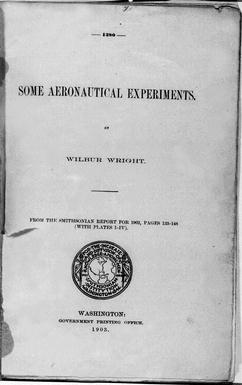
Page 1 of the printed speech.

Page 2.
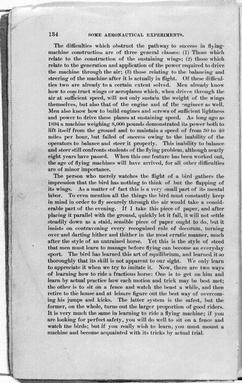
Page 3.
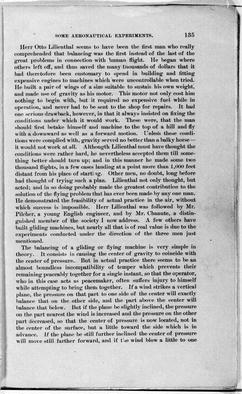
Page 4.
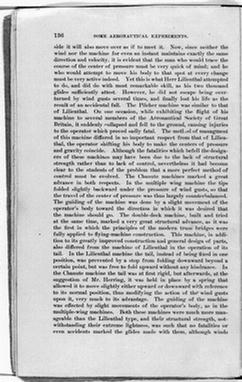
Page 5.

Page 6.

Page 7
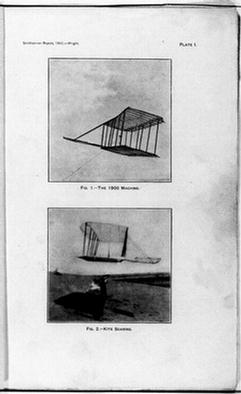
Page 8.

Page 9.
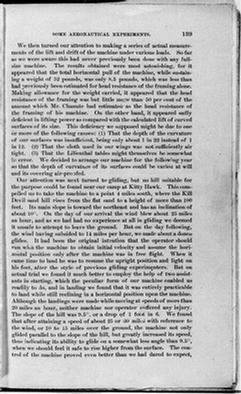
Page 10.

Page 11.
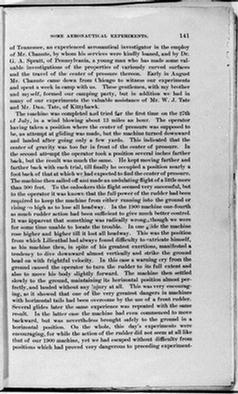
Page 12.
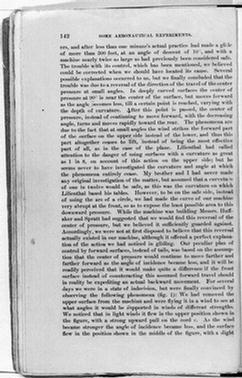
Page 13.
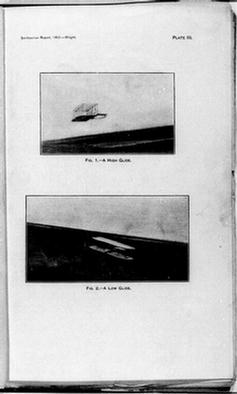
Page 14.
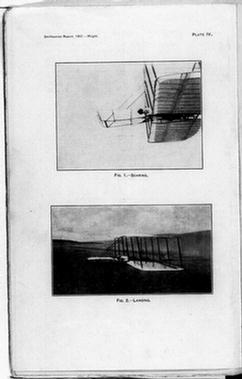
Page 15.
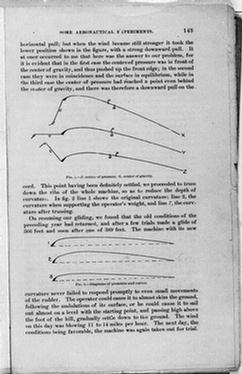
Page 16.

Page 17.

Page 18.

Page 19.

Page 20.
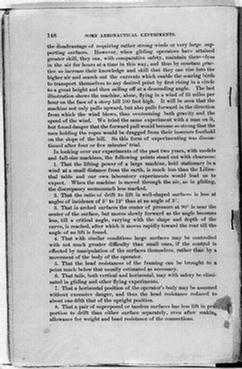
Page 21.
|